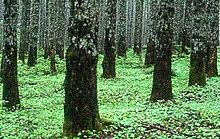
A tree plantation, forest plantation, plantation forest, timber plantation or tree farm is a forest planted for high volume production of wood, usually by planting one type of tree as a monoculture forest. The term tree farm also is used to refer to tree nurseries and Christmas tree farms.
Plantation forestry can produce a high volume of wood in a short period of time. Plantations are grown by state forestry authorities (for example, the Forestry Commission in Britain) and/or the paper and wood industries and other private landowners (such as Weyerhaeuser, Rayonier and Sierra Pacific Industries in the United States or Asia Pulp & Paper in Indonesia). Christmas trees are often grown on plantations, and in southern and southeastern Asia, teak plantations have recently replaced the natural forest.

Industrial plantations are actively managed for the commercial production of forest products. Industrial plantations are usually large-scale. Individual blocks are usually even-aged and often consist of just one or two species. These species can be exotic or indigenous. The plants used for the plantation are often genetically altered for desired traits such as growth and resistance to pests and diseases in general and specific traits, for example in the case of timber species, volumic wood production and stem straightness. Forest genetic resources are the basis for genetic alteration. Selected individuals grown in seed orchards are a good source for seeds to develop adequate planting material.
Wood production on a tree plantation is generally higher than that of natural forests. While forests managed for wood production commonly yield between 1 and 3 cubic meters per hectare per year, plantations of fast-growing species commonly yield between 20 and 30 cubic meters or more per hectare annually; a Grand Fir plantation in Scotland has a growth rate of 34 cubic meters per hectare per year,[1] and Monterey Pine plantations in southern Australia can yield up to 40 cubic meters per hectare per year.[2] In 2000, while plantations accounted for 5% of global forest, it is estimated that they supplied about 35% of the world's roundwood.[3]
The highest share of plantation forest is in South America, where this forest type represents 99 percent of the total planted-forest area and 2 percent of the total forest area. The lowest share of plantation forest is in Europe, where it represents 6 percent of the planted forest estate and 0.4 percent of the total forest area. Globally, 44 percent of plantation forests are composed mainly of introduced species. There are large differences between regions: for example, plantation forests in North and Central America mostly comprise native species and those in South America consist almost entirely of introduced species.[4]
- ^ Aldhous, J. R.; Low, A. J. (1974). The potential of Western hemlock, Western red cedar, Grand fir and Noblefir in Britain (PDF) (Report). London: H.M. Stationery Office.
- ^ Everard, J.E.; Fourt, D.F. (1974). "Monterey Pine and Bishop Pine as plantation trees in southern Britain". Quarterly Journal of Forestry. 68 (2). Royal Forestry Society: 111–125.
- ^ "Forest loss". United Nations System-wide Earthwatch. United Nations Environment Programme. Archived from the original on January 6, 2010. Retrieved October 27, 2011.
- ^ "Global Forest Resource Assessment 2020". www.fao.org. Retrieved 20 September 2020.
© MMXXIII Rich X Search. We shall prevail. All rights reserved. Rich X Search
